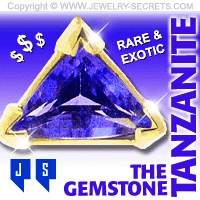TANZANITE – THE EXOTIC AND RARE GEMSTONE
BUYING TANZANITE? HOW TO SPOT A CHEAP LOW-QUALITY TANZANITE
This post contains affiliate links. If you use these links to buy something I may earn a commission. Thanks! As an Amazon Associate I also earn from qualifying purchases.

Just about every jewelry store in the U.S. carries tanzanite …
Even Amazon has some great deals on tanzanite jewelry here.
They should, the good ole USA. buys most of the tanzanites mined today.
But are you getting ripped off by that tanzanite purchase?
Do you even know what the best tanzanites are to buy? Do you want to know what the low-quality, crappy tanzanites are? Let’s dig in…
Rare color:
Tanzanites are a rare gemstone indeed. They make up some of the few gemstones in the world that have a blue-violet color (kunzites and some sapphires are other blue-violet gemstones). But does color make a gemstone rare? Not really… Although it sure does help the mass market appeal if the color is as deep and as intense as tanzanite is.
Why are tanzanites rare?
Tanzanites are rare because there’s only one location in the whole wide world to retrieve them. The mines of Tanzania. Tiffany jewelers introduced the gemstone to the American market in 1967. They also gave it the name tanzanite because of the country of origin.
So with only one set of mines in the world producing tanzanites, you can see why tanzanites have become a very popular and sought after collector’s gem.
Tanzanites are a freak of nature
Tanzanites occur because of a rare phenomenon of altitude, location and weather; Mt. Kilimanjaro gives the rare geological odds that no other location on earth can provide. It was actually stumbled upon because a brush fire made the blue-violet colors stand out… And it hasn’t stopped catching our eyes since.
Pleochroism:
This stone has a property called “pleochroism“. That means it actually gives off 3 different shades of color all at the same time. Depending on the light source and the angle viewed, you can see blues and purples, along with either reds, greens, yellows, or browns at any given moment. Tanzanites are the ultimate gemstone eye-candy.
That exhibiting color range is what makes tanzanite so appealing. The deep dark blue-violet hues are romantic, soothing, royal, mysterious and quite stunning. It’s the stone to buy.
So what’s the sad thing about tanzanite?
The sad thing about tanzanites are the fact that they’re brittle.
Tanzanite hardness:
On the Mohs scale of mineral hardness, tanzanite rates only a 6.5 – 7 on the list. In fact, garnets, amethyst, topaz, emerald and aquamarine are more durable and scratch resistant than tanzanites (and emeralds are known for being a softer stone).
So as far as being a gemstone that you can wear day in and day out, I would not advise it (special occasions or a couple times a week is fine. Just be careful!) Unless you have your tanzanite set low in the mounting or protected with a bezel or durable prongs, don’t do it! A pendant or earrings would be a better choice for tanzanite jewelry.
Tanzanites are expensive:
Tanzanites really are expensive. I would be very cautious about the whole tanzanite purchase to begin with (heck, jewelers chip tanzanites all the time just setting the stones… Which also means, check your tanzanites well for chips or breaks before you buy them, and after you get them back from repair or sizing).
Eye-clean:
The nice thing about tanzanites are that almost all stones sold on the market today, are “eye-clean“. Which means, void of any eye-visible inclusions. And most tanzanites are even eye-clean under a microscope or a 10x jeweler’s loupe as well. If you see inclusions with the bare eye in tanzanites, don’t buy them.
Best tanzanite color to buy?
Now as far as the best color to buy, there are only a few: either dark, deep blue-violet, or dark, deep blue-violet! Yes, you read that right: dark, deep blue-violet is the only true color to purchase for a tanzanite gemstone (see picture).
A lot of tanzanites you see in the mall jewelry stores will be very pale, transparent, light-violet or light-lavender in shade… AVOID THEM! They’re cheap and low quality. In other words, they’re not worth the purchase. Tanzanites are only good when they’re deep, dark blues and purples in color (some people like the lighter shades, but I’m here to say, they’re low grade).
What’s the most interesting fact about tanzanite color?
The most Interesting fact is this…
IT’S NOT REAL!
That’s a shocker to tanzanite lovers… The color is not natural. Not genuine.
That color does not come from the earth that way. When miners dig it out of Block D (one of the 4 mines in the 5 square mile area that hosts the best tanzanite colors), which is in the hills of Meralani beneath Mt. Kilimanjaro, it actually comes out of the ground as a green colored rock called “zoisite“.
Can you believe it? Who’s ever heard of zoisite?
Permanent tanzanite color:
Only with the proper heat treatment does the zoisite stone turn a beautiful deep color of blue-purple. Now while this heat treated stone will retain its color permanently… It’s not advised to submit the stone to drastic temperature changes; steam cleaners (like jewelers use) or even ultrasonic jewelry cleaners (they could fade your beautiful and expensive color). So clean your tanzanites by hand in lukewarm water (and whatever you do, keep it away from harsh acids).
With all its faults and imperfections, tanzanite still pushes forward and becomes more popular every day. It may be brittle, it may be heat treated, but the public loves the stone, and of course the color. The color is the selling point.
Tanzanites are very rare:
Not to mention the fact that tanzanites are very, very rare. Once the mines dry up… NO MORE TANZANITE! (they estimate 12-30 years.) Tanzanite is such a hot stone, that jewelry designers have taken tanzanite and run with it. They’ve taken tanzanite and turned it into a very exotic gemstone with fabulous cuts and unique shapes and settings. They’ve made tanzanites stand out in a crowd.
The birthstone for December:
Designers have made it stand out so much, that the American Gem Trade Association (in 2002) has deemed tanzanite the new alternate birthstone for December. That’s quite a feat for such a fairly new gemstone. Maybe that’s why they call tanzanite, the “gem of the 20th century” (what will they do when they run out of tanzanites?)
The mines of Tanzania (which also brings us other gems like: tsavorite, rubies & diamonds) may be high security, with guards, fences, attack dogs, and armed towers. They may have floods, revolutions, power-outages and oxygen deprived workers, but they also have the only tanzanites in the world. And gladly, that’s a stone that everyone wants.
Tanzanite is hot:
Whether it be a cheap $100 per carat tanzanite bought on a cruise ship, or a $2000 per carat dark blue-violet tanzanite bought from Tiffany & Co… It doesn’t matter. Because with tanzanite, you either buy them now, while they’re hot, or you wait until the mines dry up, and then you get it when it’s not. It’s your choice.
Buy your tanzanite Jewelry from Amazon here!
Cheers! :)














Leave a comment